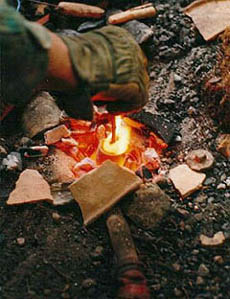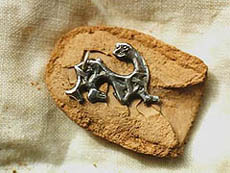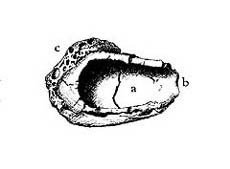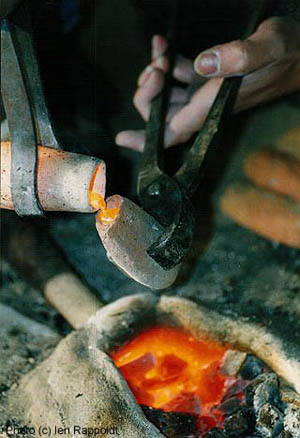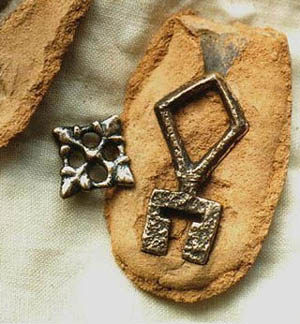Blowing New Life in Ancient and Early Medieval Metalcraft
|
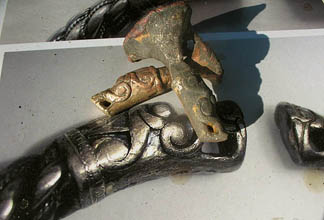 |
 |
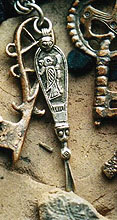
|
| In the Iron Age and Early Middle Ages, metal crafts in Scandinavia were of a very high standard as regards the execution and craft skills. Objects of bronze and silver were valued highly as utility objects, jewellery and status symbols. The production of cast metal objects was a large-scale and important occupation, as is evident from the workshops excavated in the last decades. My reconstruction of Viking Age bronze casting is based on documented Migration and Viking periods' workshop finds from Helgö and Birka.
The next step is to melt the metal in a crucible of clay mixed with sand, in a small charcoal-fired hearth. The melting requires high temperatures. Bronze for casting must reach a temperature of 1100-11500 C. This requires a generous supply of oxygen to the hearth, which is achieved by means of bellows. The jet of air from the bellows is directed towards the centre of the hearth, where the crucible stands, by a blast nozzle (tuyere). These nozzles are characteristic finds in excavations of early workshop sites.
The mould can be opened after a quarter of an hour when the metal has hardened and cooled. We now find a bronze object identical to the wax model that was previously enclosed in clay, and then melted away. Small flaws can often occur during the process. These may need to be filed or chipped away. The characteristic feature of a good casting - and of a good caster - is that the mould is made so carefully that the need for finishing is reduced to a minimum. This is true today, and it was almost certainly true in the Viking Age.
|
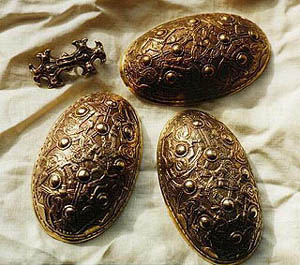
My moulds are made around models made of beeswax. At the moment (1999) I am mainly working with copies of objects found at Birka. The moulds are made from clay with a high admixture of fine sand and crushed charcoal or plant fibres. The dry mould is fired at a high temperature, at which the wax melts and drains from the mould, leaving a cavity that will then be filled with metal. This is a classical and very old moulding technique. It is called "à cire perdue", the lost-wax method.
Casting can be done after 15-20 minutes, when the metal has melted. In the meantime the mould has been heated to 500-7000C. This is necessary so that the mould will not cool down the metal too quickly, which might cause it to set before it had completely filled the mould. The crucible is lifted out with a small pair of tongs, and I also prefer to hold the mould in tongs, in the left hand, when casting. This two-hand grip makes it easier to steer the flow of metal so that we do not spill so much molten bronze. Good fine-motor skills are required to handle the hot metal.
|
| The original reason why I wanted to learn about this technology, was for use in research. My first archaeological experiments were made in an electric furnace, but I wanted to get closer to the original technology. By achieving as much practical knowledge as possible in handling bellows and charcoal and how to use sand and clay for refractory ceramics, it wouldn´t be too distant for me to use that knowledge whenever I had archaeometallurgical questions I´d like to find answers for. As a spin-off I turned out a craftsman as well. But, actually, I'm not too sorry about that! |
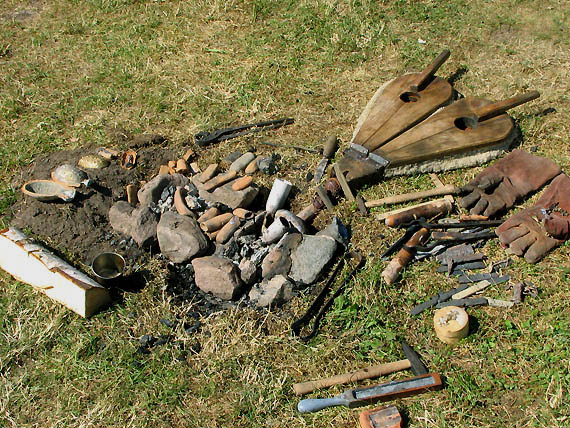
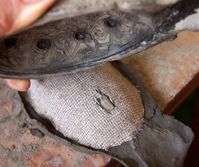 |
Paper Viking Jewellery Mould Making. Experimental and Reconstructive Aspects 2018 |
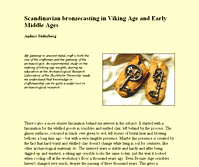 |
Paper Early medieval bronzecasting technology 1999 |
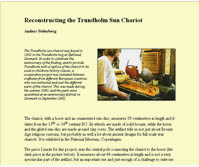 |
Reconstruction project The Danish Trundholm Sun Chariot 2002 |
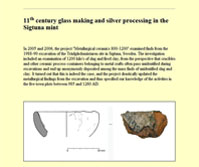 |
Research project 11th century glass-working and silver processing in the Sigtuna mint 2012 |
 |
Blueprints Would you like to build your own bellows? Download the measurements and a few photographs of the ones I built! |
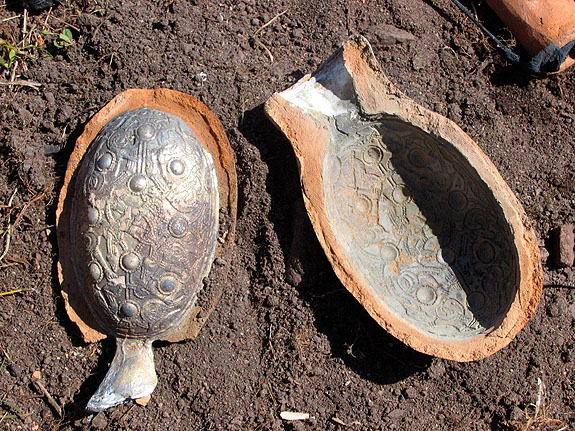
|
Published material
Söderberg, A. 1996. Schmelzkugeln - Identifikation av en hantverksprocess. Fyndmaterial från Birka och Sigtuna. CD-uppsatser i Laborativ Arkeologi 95/96. Del 2. Stockholm.
Söderberg, A. Holmquist Olausson, L. 1997. On Bronzing Iron Objects - Archaeological Evidence of Weight-manufacture in Viking Age Scandinavia? Iskos 11. Proceedings of the VII Nordic Conference on the Application of Scientific Methods in Archaeology - Savonlinna, Finland, 7 - 11 September 1996. Edgren, T. (ed). Finska Fornminnesföreningen. Vammala.
Söderberg, A. 1997. Sigtunas smältkulor - spår av vikttillverkning? Populär Arkeologi 2:1997. Gustafsson, I. (ed). Luleå.
Söderberg, A. 1999. Blowing new life in old technology - Viking Age bronze casting. Viking Heritage Newsletter 1/1999 . Hoffman, O. (ed.). Visby.
Söderberg, A. 2001. Scandinavian Iron Age and Early Medieval ceramic moulds - lost wax or not or both? Proceedings of the 1st International Workshop. Experimental and Educational aspects on Bronze Metallurgy, Wilhelminaoord 18 - 22 October 1999. Tulp, C. Meeks, N. Paardekooper, R. (eds). Vereniging voor Archeologische Experimenten en Educatie. Leiden.
Meeks, N. Tulp, C. Söderberg, A. 2001. Precision lost wax casting. Proceedings of the 1st International Workshop. Experimental and Educational aspects on Bronze Metallurgy, Wilhelminaoord 18 - 22 October 1999. Tulp, C. Meeks, N. Paardekooper, R. (eds). Vereniging voor Archeologische Experimenten en Educatie. Leiden.
Söderberg, A. 2002. Metalliska spår efter gjuteriverksamhet - en skiss till en arkeologisk fältmetod. Fornvännen 97 (4/2002) Journal of Swedish Antiquarian Research. Trotzig, C.G. Lamm, J.P. Tegnér, G. Rundquist, M. (eds). KVHAA. Stockholm.
Söderberg, A. 2003. Herstellung von Ovalfibeln. Karfunkel Codex Nr 1. Wikinger. Beckers-Dohlen, C. (ed). Wald-Michelbach.
Söderberg, A. 2003. Järnålder till tidig medeltid; järnet som samhällsbildare, ädelmetaller som samhällskitt. I gruva och grav. Metallhantering från bronsålder till nyare tid. Berg, L. Forshell, H. Söderberg, A. (eds). Stockholm.
Söderberg, A. 2004. Metallurgic ceramics as a key to Viking Age workshop organisation. Jonas 14 - Journal of nordic archeological science. Lidén, K. (ed). The Archaeological Research Laboratory. Stockholm.
Gustafsson, Ny B. Söderberg, A. 2005. The tidy metalworkers of Fröjel. Viking Heritage Magazine 3/2005. Engberg-Ekman, M (ed). Visby.
Söderberg, A. Gustafsson, Ny B. 2006. A Viking Period silver workshop in Fröjel, Gotland. Fornvännen 101 (1/2006) Journal of Swedish Antiquarian Research. Trotzig, C.G. Lamm, J.P. Tegnér, G. Rundquist, M. (eds). KVHAA. Stockholm.
Söderberg, A. 2006. Om två metallurgiska processer knutna till vikingatidens betalningsväsende. Situne Dei 2006. Tesch, S. Edberg, R. Wikström, A. (eds). Sigtuna.
Söderberg, A. Gustafsson, Ny B. 2007. Från prestigevarugjutning till myntning, tidigmedeltida metallurgi i kvarteret Trädgårdsmästaren, Sigtuna. Situne Dei 2007. Tesch, S. Edberg, R. Wikström, A. (eds). Sigtuna.
Gustafsson, Ny B. Söderberg, A. 2007. En senvikingatida silververkstad i Fröjel. Gotländskt Arkiv 2007, meddelanden från Föreningen Gotlands fornvänner. Visby.
Söderberg, A. 2008. Metallurgical clay packages. Excavations at Helgö XVII. Lamm, K. Clarke, H. (eds). KVHAA. Stockholm.
Söderberg, A. 2008. Metall- och glashantverk. På väg mot Paradiset - arkeologisk undersökning i kvarteret Humlegården 3 i Sigtuna 2006. Wikström, A. (ed). Meddelanden och rapporter från Sigtuna Museum nr 33. Sigtuna.
Söderberg, A. 2011. Eyvind Skáldaspillir's silver - refining and standards in pre-monetary economies in the light of finds from Sigtuna and Gotland. Situne Dei 2011. Edberg, R. Wikström, A. (eds). Sigtuna.
Wikström, A. Söderberg, A. Edberg, R. Pettersson, B. Roslund, M. 2011. Fem stadsgårdar - arkeologisk undersökning i kv. Trädgårdsmästaren 9 & 10 i Sigtuna 1988-90. Meddelanden och rapporter från Sigtuna Museum nr 52. Sigtuna.
Söderberg, A. 2013. Om stratigrafi, tomtmönster och hantverk i kvarteret Urmakaren, Sigtuna. Situne Dei 2013. Claesson. E, Edberg, R. Källström. M. (eds). Sigtuna.
Gustavson, H. & Söderberg, A. 2014. Spår av skrivkunnighet och skrivvanor i det tidigmedeltida Sigtuna. Situne Dei 2014. Söderberg, A Claesson. E, Edberg, R. Källström. M. (eds). Sigtuna.
Söderberg, A. 2014. The brazing of iron and the metalsmith as a specialised potter. The Old Potter's Almanack, Vol 19, No 2 (2014) Spataro. M. (ed). Heidelberg.
Söderberg, A. 2015. The brazing package that King Olof's goldsmith forgot to open. Fornvännen - Journal of Swedish Antiquarian Research, 2015:1. Larsson, L. et al (eds). Stockholm.
Söderberg, A. 2016. Medieval string instrument finds from Sigtuna, including the earliest known key for a possible nyckelharpa. Fornvännen - Journal of Swedish Antiquarian Research, 2016:2. Larsson, L. et al (eds). Stockholm.
O'Meadhra, U. & Söderberg, A. 2017. En säregen knivtyp i gränslandet mellan Jelling-, Mammen- och Ringerikestil. Situne Dei, Årsskrift för sigtunaforskning och historisk arkeologi. Söderberg. A. Hedenstierna-Jonson, C. Kjellström, A. Källström, M. Ljung, C. Runer, J. (eds). Sigtuna.
Söderberg, A. 2017. Några "nyfynd" ur museets magasin. Situne Dei, Årsskrift för sigtunaforskning och historisk arkeologi. Söderberg. A. Hedenstierna-Jonson, C. Kjellström, A. Källström, M. Ljung, C. Runer, J. (eds). Sigtuna.
Söderberg, A. 2018. Viking Jewellery Mould Making. Experimental and Reconstructive Aspects. EXARC Journal 2018:4. Dvoráková, K. et al (eds). Leiden.
Edberg, R. & Söderberg, A. 2018. Insignier, amuletter, krigsleksaker? Sigtunas miniatyryxor än en gång. Situne Dei, Årsskrift för sigtunaforskning och historisk arkeologi. Söderberg. A. Hedenstierna-Jonson, C. Kjellström, A. Källström, M. Ljung, C. Runer, J. (eds). Sigtuna.
Söderberg, A. 2019. Ett parallellföremål till runsyllabariet från Sigtuna. Situne Dei, Årsskrift för sigtunaforskning och historisk arkeologi. Söderberg. A. Hedenstierna-Jonson, C. Kjellström, A. Källström, M. Ljung, C. Runer, J. (eds). Sigtuna.
Söderberg, A. 2020. En årsringsdatering av det övre bjälklaget i S:t Pers mittorn, Sigtuna. Situne Dei, Årsskrift för sigtunaforskning och historisk arkeologi. Söderberg. A. Hedenstierna-Jonson, C. Kjellström, A. Källström, M. Ljung, C. Runer, J. (eds). Sigtuna.
Söderberg, A. 2020. A handful of String Instrument Finds from Medieval Sigtuna, Sweden. The Archaeology of Sound, Acoustics and Music: Studies in Honour of Cajsa S. Lund. Kolltveit, G. & Rainio, R. eds.). Berlin.
Wikström, A, Söderberg, A & Roslund, M. (eds.). 2021. Hos Herr Niklas och annat skrivkunnigt folk. Arkeologisk undersökning i kvarteret Professorn 1 i Sigtuna 1999-2000. MORR 63. Sigtuna.
Söderberg, A. 2021. Föremålsfynden. Hos Herr Niklas och annat skrivkunnigt folk. Arkeologisk undersökning i kvarteret Professorn 1 i Sigtuna 1999-2000. MORR 63. Wikström, A, Söderberg, A & Roslund, M. (eds.). Sigtuna.
Söderberg, A. 2021. Hantverk i mynthusmiljö. MORR 64. Sigtuna.
Söderberg, A. 2021. The Sigtuna scorifiers in context. Situne Dei, Årsskrift för sigtunaforskning och historisk arkeologi. Söderberg. A. Hedenstierna-Jonson, C. Kjellström, A. Källström, M. Ljung, C. Runer, J. (eds). Sigtuna.
Edberg, R. KArlsson, J. & Söderberg, A. 2022. Spelföremål Frå:n Sigtuna. MORR 65. Sigtuna.
|
|
Links
Umha Aois - IE
Sigtuna Museum - SE
|
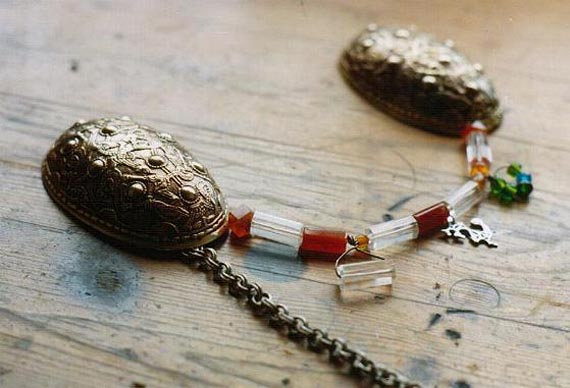
© Anders Söderberg [infoATvikingbronze.com] - Site created January 1 1999 - Last update February 26 2023 |
.

